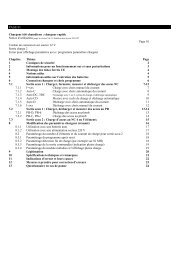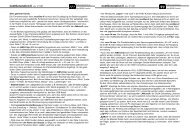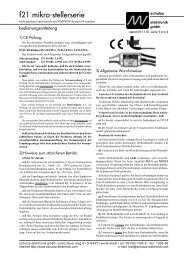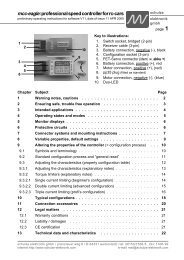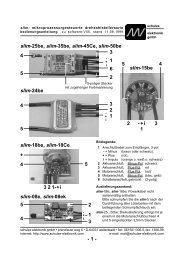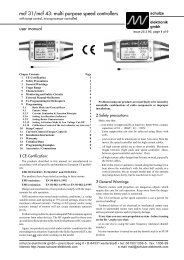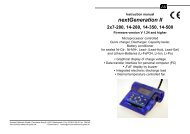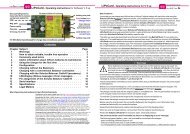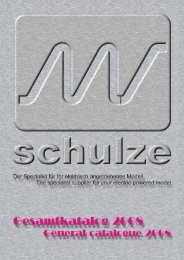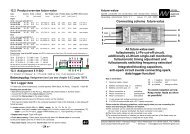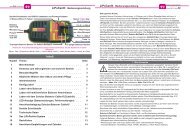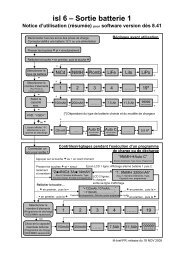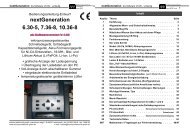ecolader: rapid discharger/charger series - Schulze Elektronik GmbH
ecolader: rapid discharger/charger series - Schulze Elektronik GmbH
ecolader: rapid discharger/charger series - Schulze Elektronik GmbH
You also want an ePaper? Increase the reach of your titles
YUMPU automatically turns print PDFs into web optimized ePapers that Google loves.
<strong>ecolader</strong>: <strong>rapid</strong> <strong>dis<strong>charger</strong></strong>/<strong>charger</strong> <strong>series</strong><br />
Operating instructions for software V1.04, date of issue 05 MAY 1998<br />
8.15.6 Aut_DC, Fix_DC<br />
(_ = 1...8 and X)<br />
Purpose<br />
The battery care programs (1DC ... XDC)<br />
balance your batteries in order to erase any<br />
existing memory effect, or to force the<br />
chemistry to "get going". Those batteries in<br />
particular which are only slightly discharged<br />
(e.g. transmitter and receiver batteries),<br />
need to be discharged completely and then<br />
recharged on a regular basis. Irregularly<br />
maintained or brand-new packs often require<br />
this procedure to be repeated several<br />
times in sequence.<br />
Description<br />
The battery connected to the <strong>charger</strong> is discharged<br />
to the final discharge voltage using<br />
the xxxx-D program, and then recharged<br />
using the xxxx C program (repeated n times<br />
if you are using the xxx_DC program). The<br />
program continues charging until the peak is<br />
detected, then switches to a trickle charge.<br />
The initial value for the discharge current is<br />
calculated from the maximum discharge<br />
power and/or the maximum permissible discharge<br />
current for the <strong>ecolader</strong>.<br />
When the final discharge voltage is reached<br />
using one of the automatic programs, the<br />
discharge current is reduced until it reaches<br />
a low value.<br />
Continuous charge current adjustment relative<br />
to the pack's energy absorption capacity<br />
in the automatic programs.<br />
The calculated charge current is reduced if<br />
there is a danger that the unit will overheat<br />
or be overloaded.<br />
Select criteria:<br />
If the calculated charge currents turn out too<br />
low in automatic mode due to poor battery<br />
condition, the time limiter eventually trips.<br />
For this reason it may make sense to start<br />
by using a fixed current program (e.g.<br />
Fix2DC) and a current of 0.5 C ... 1 C until<br />
the battery has to some extent "come back<br />
to life".<br />
If the battery refuses to accept currents<br />
above 1 C ... 2 C in automatic mode, it is either<br />
unsuitable for <strong>rapid</strong>-charging, or it is approaching<br />
the end of its life; it's "had it".<br />
8.15.7 Aut_CD, Fix_CD<br />
(_ = 1...8 and X)<br />
schulze<br />
elektronik<br />
gmbh<br />
Page 21<br />
Purpose<br />
This program is ideal for studying the<br />
changing behaviour of individual battery<br />
packs. It provides a useful means of checking<br />
their usefulness based on varying capacity<br />
data.<br />
Description<br />
The battery connected to the <strong>charger</strong> is<br />
charged up using the xxxx C program, and<br />
then discharged again using the xxxx-D program.<br />
In the automatic programs the <strong>ecolader</strong> automatically<br />
and regularly calculates the optimum<br />
charge current for the battery.<br />
The calculated charge current is reduced if<br />
there is a danger that the unit will overheat<br />
or be overloaded. The program continues<br />
charging until the peak is detected.<br />
After this, the battery connected to the unit<br />
is discharged to the final discharge voltage.<br />
The initial value for the discharge current is<br />
calculated from the maximum discharge<br />
power and/or the maximum permissible discharge<br />
current for the <strong>ecolader</strong>.<br />
When the final discharge voltage is reached<br />
using one of the automatic programs, the<br />
discharge current is reduced until it reaches<br />
a low value.<br />
Select criteria:<br />
If the calculated charge currents turn out too<br />
low in automatic mode due to poor battery<br />
condition, the time limiter eventually trips.<br />
For this reason it may make sense to start<br />
by using a fixed current program (e.g.<br />
Fix2DC) and a current of 0.5 C ... 1 C until<br />
the battery has to some extent "come back<br />
to life".<br />
If the battery refuses to accept currents<br />
above 1 C ... 2 C in automatic mode, it is either<br />
unsuitable for <strong>rapid</strong>-charging, or it is approaching<br />
the end of its life; it's "had it".<br />
Important with all combination programs:<br />
These programs only function if you are<br />
using peak-detect or temperature termination.<br />
Exceeding a charge quantity or<br />
charge time causes the combination program<br />
to be halted.<br />
Setting the number of cycles: see Section 8.19<br />
schulze elektronik gmbh • prenzlauer weg 6 • D-64331 weiterstadt • tel: 06150/1306-5, fax: 1306-99<br />
internet: http://www.schulze-elektronik.com e-mail: mail@schulze-elektronik.com



